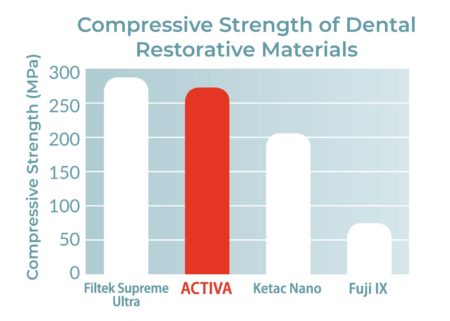Physical Properties
Strength
Compressive and Diametral Tensile Strength of ACTIVA BioACTIVE-RESTORATIVE is comparable to composites and far superior to glass ionomers and RMGIs.
Filtek = Composite / ACTIVA = BioACTIVE Restorative / Ketac Nano = RMGI / Fuji IX = GI
Filtek, Ketac Nano and Fuji IX are trademarks of 3M ESPE, 3M ESPE and GC respectively.
Source: University testing17




Compressive and Flexural Strength of ACTIVA BioACTIVE-BASE/LINER is much greater than resin-modified base/liners and RMGIs.
ACTIVA = BioACTIVE Base/Liner; Fuji Lining & Vitrebond = RMGI
TheraCal = Resin-Modified Calcium Silicate
Fuji Lining, Vitrebond and TheraCal are trademarks of GC, 3M and Bisco respectively
Source: Pulpdent testing18
Shear bond strength of ACTIVA BioACTIVE-CEMENT compares favorably with leading cements and is superior to resin modified glass ionomer and calcium aluminate-glass ionomer cements tested.
ACTIVA = Bioactive Cement; RelyX Unicem Automix = Self-adhesive Cement; FujiCEM2 = RMGI; Ceramir = Calcium Aluminate-GI
Source: University testing38
RelyX, FujiCEM and Ceramir are trademarks of 3M ESPE, GC and Doxa respectively.

Wear
Volume wear of ACTIVA BioACTIVE-RESTORATIVE is comparable to composites and far less than glass ionomer.
Fuji IX = Glass Ionomer / ACTIVA = Bioactive Restorative / Tetric = Composite / Filtek Supreme = Composite
Fuji IX, Tetric and Filtek are trademarks of GC, Ivoclar Vivadent and 3M ESPE respectively.
Source: University testing 27


When evaluated for surface wear resistance, ACTIVA BioACTIVE-RESTORATIVE performed better than all other materials tested with abrasive toothpaste and was comparable to flowable composites with non-abrasive toothpaste.
ACTIVA = Bioactive Restorative / Tetric EvoFlow and Beautifil Flow Plus = Flowable Composite / Ketac Nano and Vitrebond Plus = RMGI / Fuji Triage = Glass Ionomer
Tetric EvoFlow, Beautifil, and Fuji Triage are trademarks of Ivoclar Vivadent, Shofu, and GC respectively. Ketac and Vitrebond are trademarks of 3M ESPE. Source: University testing 28
Toughness, Fatigue Limit, Deflection at Break
ACTIVA’s rubberized resin component provides unparalleled toughness and resilience. Toughness, measured by deflection at break using a 3-point bend test, is the ability of a strong, hard material to absorb stress, dissipate forces and resist fracture when a load is applied. Fatigue limit is determined by the incremental load required to cause fracture within a defined number of cycles The diagram shows a load applied to a hard material in a the 3-point bend test.
ACTIVA samples far outperform all leading restorative materials tested for toughness. Deflection at Break of ACTIVA is 2-3 times greater than composites and 5-10 times greater than GIs and RMGIs.
Fig. 1 Illustration shows 3-point bend test
Fig. 2 Filtek = Composite; ACTIVA = BioACTIVE Restorative; Ketac Nano = RMGI; Fuji IX = GI
Filtek, Ketac Nano and Fuji IX are trademarks of 3M ESPE, 3M ESPE and GC respectively
Source: University testing5,17


Deflection at break of ACTIVA BioACTIVE-CEMENT is significantly greater than that of other leading materials tested and acts like a ligament to absorb stress and resist fracture and chipping.
ACTIVA = Bioactive Cement; RelyX Unicem Automix = Self-adhesive Cement; FujiCEM2 = RMGI; Ceramir = Calcium Aluminate-GI
RelyX, FujiCEM and Ceramir are trademarks of 3M ESPE, GC and Doxa respectively.

Water Absorption
A controlled and relatively low level of water absorption is advantageous for bioactive materials, which require water to unlock their bioactive properties and potential for ionic exchange. Excessive water absorption can compromise the physical properties of restorative and base/liner materials over time.
Water absorption of ACTIVA BioACTIVE-RESTORATIVE is designed to be slightly higher than composites, which are hydrophobic and not bioactive, and is significantly less than glass ionomers and RMGIs.
ACTIVA = BioACTIVE Restorative; Filtek Supreme Ultra = Composite; Ketac Nano = RMGI, Fuji IX = GI; Fuji II LC = RMGI


Water absorption of ACTIVA BioACTIVE-BASE/LINER is far less than RMGIs. Water absorption of TheraCal is 7 times greater than ACTIVA.
ACTIVA = BioACTIVE Base/Liner; Fuji Lining & Vitrebond = RMGI;
TheraCal = Resin-Modified Calcium Silicate
Fuji Lining, Vitrebond and TheraCal are trademarks of GC, 3M and Bisco respectively.
Filtek, Ketac Nano and Fuji IX/Fuji II LC are trademarks of 3M ESPE, 3M ESPE and GC respectively
Source: Pulpdent testing8,20
Water absorption of ACTIVA BioACTIVE-CEMENT compares with the leading self-adhesive cement and is far less than the RMGI and calcium aluminate-glass ionomer cements tested.
ACTIVA = Bioactive Cement; RelyX Unicem Automix = Self-adhesive Cement; FujiCEM2 = RMGI; Ceramir = Calcium Aluminate-GI
Source: University testing37
RelyX, FujiCEM and Ceramir are trademarks of 3M ESPE, GC and Doxa respectively.

Water Solubility
Low water solubility is important for ensuring the durability and longevity of a dental material. The patented resins and reactive glass fillers in ACTIVA products are balanced to deliver both bioactivity, which requires water, and durability. This unique combination of attributes, when combined with esthetics, sets ACTIVA apart from all other restorative materials.
ACTIVA has remarkably low water solubility that compares favorably with leading composites and is far lower than glass ionomers and RMGIs.
Filtek, Ketac Nano and Fuji are trademarks of 3M ESPE, 3M ESPE and GC respectively
Source: Pulpdent testing20

Radiopacity
The radiograph compares the radiopacity of a 1mm thick circular disk of ACTIVA BioACTIVE-RESTORATIVE to an aluminum step fixture. The steps on the fixture are in half millimeter increments, and notches on the fixture indicate the 1mm and 2mm steps.
The radiopacity of ACTIVA is equivalent to 1.5mm of aluminum.







